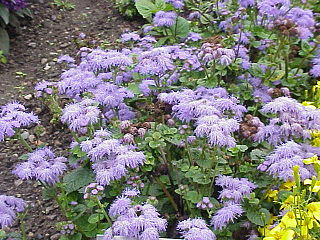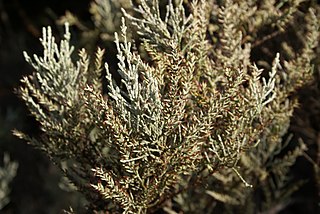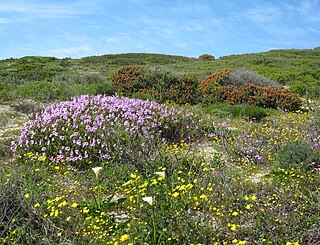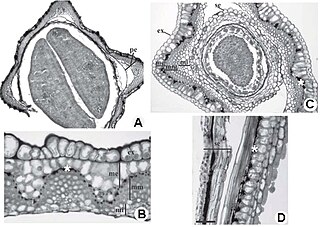
Asterales is an order of dicotyledonous flowering plants that includes the large family Asteraceae known for composite flowers made of florets, and ten families related to the Asteraceae. While asterids in general are characterized by fused petals, composite flowers consisting of many florets create the false appearance of separate petals.

The family Asteraceae, with the original name Compositae, consists of over 32,000 known species of flowering plants in over 1,900 genera within the order Asterales. Commonly referred to as the aster, daisy, composite, or sunflower family, Compositae were first described in the year 1740. The number of species in Asteraceae is rivaled only by the Orchidaceae, and which is the larger family is unclear as the quantity of extant species in each family is unknown.

Viscount Alexandre Henri Gabriel (vicomte) de Cassini was a French botanist and naturalist, who specialised in the sunflower family (Asteraceae).

The Heliantheae are the third-largest tribe in the sunflower family (Asteraceae). With some 190 genera and nearly 2500 recognized species, only the tribes Senecioneae and Astereae are larger. The name is derived from the genus Helianthus, which is Greek for sun flower. Most genera and species are found in North America and South America. A few genera are pantropical.

The Gnaphalieae are a tribe of flowering plants in the family Asteraceae. It is most closely related to the tribes Anthemideae, Astereae, and Calenduleae.

Eupatorieae is a tribe of over 2000 species of plants in the family Asteraceae. Most of the species are native to tropical, subtropical, and warm temperate areas of the Americas, but some are found elsewhere. Well-known members are Stevia rebaudiana, a number of medicinal plants (Eupatorium), and a variety of late summer to autumn blooming garden flowers, including Ageratum (flossflower), Conoclinium (mistflower), and Liatris.

Gnaphalium is a genus of flowering plants in the family Asteraceae, commonly called cudweeds. They are widespread and common in temperate regions, although some are found on tropical mountains or in the subtropical regions of the world.

Tageteae is a tribe of the plant family Asteraceae. It consists of approximately 260 species divided among 32 genera. All are found in the New World, with a center of diversity in the Mexican highlands. The type genus is Tagetes (marigolds).

The Cardueae are a tribe of flowering plants in the daisy family (Asteraceae) and the subfamily Carduoideae. Most of them are commonly known as thistles; four of the best known genera are Carduus, Cynara, Cirsium, and Onopordum.

The Cichorioideae are a subfamily of the family Asteraceae of flowering plants. Familiar members of Cichorioideae include lettuce, dandelions, chicory and Gazania species. The subfamily comprises about 240 genera and about 2900 species. It is heterogeneous and hard to characterize except with molecular characters.

Rune Bertil Nordenstam is a Swedish botanist and professor emeritus at the Swedish Museum of Natural History in the Department of Phanerogamic Botany. He has worked with Colchicaceae, Senecioneae and Calenduleae, was the editor of Compositae Newsletter newsletter since 1990, and is a Tribal Coordinator for The International Compositae Alliance with responsibility for the tribes Calenduleae and Senecioneae.

Madieae is a tribe of flowering plants in the family Asteraceae. It is sometimes considered a subtribe of Heliantheae. Notable species include the tarweeds of the Western United States as well as the silverswords of Hawaii.
Teixeiranthus is a genus of flowering plants in the tribe Eupatorieae within the family Asteraceae. As of May 2023, the Global Compositae Database accepted only one species, Teixeiranthus foliosus, endemic to north-east Brazil.

Stoebe is a genus of plants in the tribe Gnaphalieae within the family Asteraceae. The genus is confined to the Cape Provinces of South Africa.

Cape Flats Dune Strandveld is an endangered vegetation type. This is a unique type of Cape Strandveld that is endemic to the coastal areas around Cape Town, including the Cape Flats.

Metalasia muricata, commonly known as white bristle bush or blombos, is a hardy virgate or twiggy shrub with honey-scented flowers usually 2–4 m tall, woody with a rounded crown. It is native to the Cape Provinces of South Africa, where it is an important component of the coastal and mountain fynbos regions. It is encountered in a number of forms in its extended distribution, some of which are tolerant of frost, wind and poor sandy soils.

Helenieae is a tribe of the plant family Asteraceae. The type genus is Helenium, but the best known members of the tribe are the Gaillardia. Helenieae are usually placed in their own tribe, but some authors include this and several other tribes as subtribes within a broader definition of the tribe Heliantheae.

The Nassauvieae are a tribe of flowering plants in the family Asteraceae.

Phytomelanin (phytomelan) is a black, inert, organic material that forms a crust-like covering of some seeds, commonly found in Asparagales and Asteraceae but uncommon in other taxonomic groupings. Phytomelanin is found in most families of the Asparagales. It is mechanically hard and forms a resistant substance, although it is more pliable in the developing fruit, hardening later. Chemically it appears to be a polyvinyl aromatic alcohol, and is thought to be exuded from the hypodermis. It appears to provide resistance to insect predators and desiccation.

Metalasia densa, the bristle bush or blombos, is a species of flowering plant in the family Asteraceae, native to South Africa and Lesotho. A perennial shrub reaching 2.5 m (8 ft), it is fire-adapted.


















